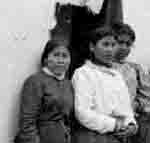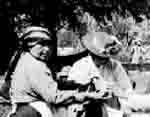|
We
know very little about aboriginal views of sexuality although it seems
certain that aboriginal sexuality was characterized in a very different
way than the European perception. However, this sexuality cannot be
discussed universally since the various tribes did not all treat the
subject the same way. What follows is a brief sketch gleaned
largely from the research of Jennifer Windecker.
For
example, the matrilineal Ts’msyen and Nisg’a tribes
considered men and women to be economic and social equals in
contributing to the community. Sexually relations with high
ranking women was seen to be positive for both men and women and was
accompanied by gift exchanges. On the other hand, in other tribes
pre-marital chasity and most marital fidelity were demanded, especially
of women from high-ranking families. Despite these
differences, one distinction of Aboriginal sexuality that does remain
consistent is the lack of social stigma around the topic
(Windecker). Many place names contain sexual references and many
of the traditional stories included references to sexual behaviour.
A strong sense of sexuality permeated Aboriginal life before
Europeans came along, viewed it was viewed in a positive light
(Windecker).
Before white men entered the scene, pre- or extra-marital sexual
activity was honoured among certain peoples with public gifts to her or
her family. Upon the arrival of whites, the use of
sexuality as a lucrative income became exploited during the fur trade
and institutionalized during the gold rush through dance houses among a
small percentage of Aboriginal women.
Gold
rush “prostitution” involved the coerced use of slave women
but free women also found they could exchange sex for wealth and
earnings by sexual echange reached an all time high. A few
Indigenous women acquired new goods, and likely elevated status,
amongst her people. (Windecker). Regardless of the fact
that every such sexual exchange involved a European as well as an
indigenous person, white society applied the stigma to the Aboriginal
women. The sexualization of Native women was often based on the needs
and desires, physical, social, or financial, of the men in power (JB
“Taming” 258).
|



